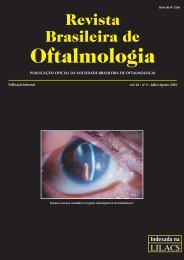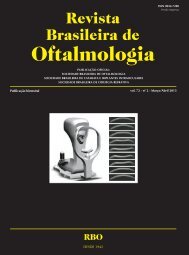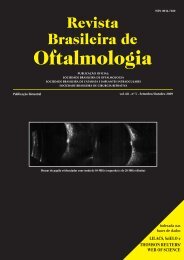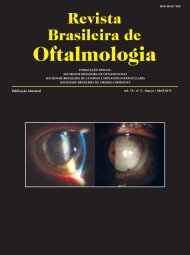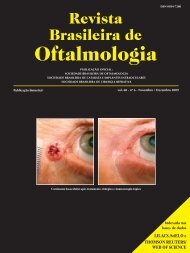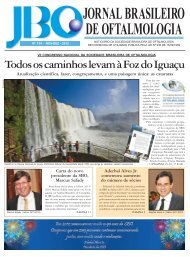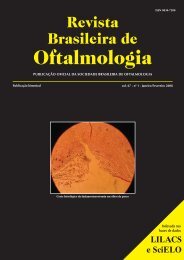Jan-Fev - Sociedade Brasileira de Oftalmologia
Jan-Fev - Sociedade Brasileira de Oftalmologia
Jan-Fev - Sociedade Brasileira de Oftalmologia
- No tags were found...
You also want an ePaper? Increase the reach of your titles
YUMPU automatically turns print PDFs into web optimized ePapers that Google loves.
Retinal nerve fiber layer loss documented by optical coherence tomography in patients with optic tract lesions<br />
49<br />
INTRODUCTION<br />
Optic tract lesions, although infrequently<br />
recognized, are of great importance because<br />
they represent the first region beyond the optic<br />
chiasm where lesions produce a homonymous<br />
hemianopia and because of its diagnostic implications.<br />
The etiologies are mostly primary tumors of the<br />
supraselar area such as cranyopharingeomas and<br />
pituitary a<strong>de</strong>nomas but giant aneurysms, vascular processes,<br />
<strong>de</strong>myelinating disease and trauma can also<br />
occur. In most cases, the clinical findings are distinctive<br />
enough to establish a correct diagnosis: typically the<br />
patient has normal visual acuity in both eyes, a<br />
homonymous hemianopia contralateral to the lesion<br />
and a relative afferent pupillary <strong>de</strong>fect in the eye with<br />
the temporal visual field <strong>de</strong>fect (1, 2) . Hemianopia may<br />
be complete or partial and when incomplete, the visual<br />
field <strong>de</strong>fect is most likely incongruous, although vascular<br />
lesions may occasionally produce congruous optic tract<br />
hemianopia (3) .<br />
Abnormalities in the retinal nerve fiber layer<br />
(RNFL) in long standing optic tract lesions are also<br />
characteristic. In such cases, there is a “wedge” or<br />
“band” of horizontal RNFL loss and pallor of the optic<br />
disc in the eye contralateral to the lesion (the eye with<br />
the temporal field loss) (1) . This pattern is caused by<br />
atrophy of the RNFL originating nasal to the fovea<br />
and is i<strong>de</strong>ntical with that from chiasmal syndromes<br />
i<strong>de</strong>ntified on ophthalmoscopy as band atrophy (BA)<br />
(4, 5).<br />
of the optic nerve At the same time, there is<br />
generalized pallor of the optic disc in the eye on the<br />
si<strong>de</strong> of the lesion associated with severe loss of the<br />
RNFL in the superior and inferior arcuate lesions that<br />
comprise the majority of fibers originating from the<br />
ganglion cells temporal to the fovea. The RNFL loss<br />
may be evaluated on ophthalmoscopy as well as with<br />
several instruments including scanning laser<br />
polarimetry and optical coherence tomography.<br />
Optical coherence tomography (OCT) is an in<br />
vivo technique for acquisition of cross-sectional images<br />
of retinal structures from which estimates of the<br />
thickness of retinal layers can be ma<strong>de</strong>. Several studies<br />
have documented the ability of OCT to <strong>de</strong>monstrate<br />
RNFL loss in eyes with BA of the optic nerve from<br />
chiasmal lesions (6-8). However, to our knowledge, only<br />
one previous study using an earlier version of the OCT<br />
instrument (OCT 1) has evaluated RNFL loss in optic<br />
tract lesions (9). The purpose of this paper is therefore to<br />
<strong>de</strong>monstrate Stratus-OCT findings in 2 patients with<br />
optic tract lesions.<br />
Case reports<br />
Case 1: A 29-year-old man complained of left si<strong>de</strong>d<br />
visual loss 4 years previously when he had a severe<br />
cranial trauma from a motorcycle acci<strong>de</strong>nt. He was<br />
unconscious for a period of 10 days and noticed left si<strong>de</strong>d<br />
visual loss as soon as he awoke and his visual <strong>de</strong>ficit<br />
remained unchanged ever since. Ophthalmic<br />
examination revealed a visual acuity was 20/20 in each<br />
eye. Eye movements, slit lamp examination and<br />
intraocular measurements were normal. Pupils were<br />
equal in size and reactive to light and near stimulation.<br />
Swinging flashlight test revealed a + left relative afferent<br />
pupillary <strong>de</strong>fect. Fundus examination showed diffuse<br />
optic disc pallor in the right eye (OD) and BA of the<br />
optic disc in the left eye (OS) (Figure 1). Visual field<br />
examination revealed a complete left homonymous<br />
hemianopia. In OD there was complete absence of the<br />
nasal hemifield and in OS a complete temporal<br />
hemianopia was present. (Figure 1). Stratus - OCT (Carl<br />
Zeiss Meditec, Dublin, California, USA) examination<br />
using a peripapillary fast retinal nerve fiber layer<br />
(RNFL) program, showed in the right RNFL thickness<br />
reduction at the superior and inferior quadrants while in<br />
the left eye a diffuse loss of RNFL most markedly in the<br />
temporal and nasal quadrants of the disc (Figure 1).<br />
Case 2: A 23-year-old man presented with<br />
headache and was found on a routine eye examination<br />
to have pale optic discs. The patient was referred for<br />
neurologic investigation and a magnetic resonance<br />
imaging scan disclosed the presence of a large pituitary<br />
macroa<strong>de</strong>noma. After tumor discovery a left incongruous<br />
homonymous hemianopia was found on visual field<br />
examination. The tumor was surgically removed with<br />
slight improvement in visual fields. Six months after<br />
surgery he was examined by us and found to have best<br />
corrected visual acuity of 20/20 in both eyes. He had an<br />
incongruous left homonymous hemianopia with a<br />
hemianopic scotoma located in the nasal hemifield in<br />
OD and a temporal field <strong>de</strong>fect in OS (Figure 2). Fundus<br />
examination revealed diffuse optic disc pallor in OD<br />
and BA of the optic nerve in OS. Stratus - OCT<br />
examination using a peripapillary fast retinal nerve fiber<br />
layer (RNFL) program, showed in the OD reduced<br />
RNFL in the superior and inferior quadrants while in the<br />
OS there was diffuse loss of the RNFL, most marked in<br />
the temporal and nasal quadrants of the disc (Figure 2).<br />
DISCUSSION<br />
In our case Stratus -OCT <strong>de</strong>monstrated RNFL loss<br />
involving predominantly the nasal and temporal portions<br />
Rev Bras Oftalmol. 2008; 68 (1): 48-52



